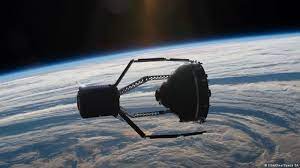Chinese rocket lifts a satellite in space and throws it in the trash

Last month, a Star Wars movie-like view was seen in Earth’s orbit. In late January, a Chinese satellite was shown to have intercepted another long-dormant satellite. A few days later, 300 km away, he was seen throwing it into the part of the orbit called the graveyard. The probability of debris hitting a spacecraft in that part is negligible.
Dr. Brian Fluwelling presented this rare information in a webinar held last month by the Center for Strategic and International Studies and the Secure World Foundation. He is the Chief Space Situational Awareness Architect at Axoanalytic Solutions, a private American company. The company tracks the position of satellites using a business global network of giant optic telescopes.
On 22 January, the Chinese spacecraft SJ-21 was seen moving from its assigned position towards the defunct satellite Compass-G2. A few days later, SJ-21, attached to Compass-G2, was found to be changing its orbit. Chinese officials have not yet confirmed the existence of any such space craft, that is, a satellite carrying another satellite.
Exoanalytic’s video showed that over the next few days, the two spacecraft began to oscillate in a westerly direction. The two parted ways on 26 January and G2 was thrown into deep darkness. Compass-G2 or Baido-2 G2 is the spacecraft of China’s Baidu-2 operational satellite system. It became useless shortly after being sent to space in 2009. For more than ten years, that metal cage has been wandering around the Earth’s orbit, where millions of other debris are scattered.
SJ-21 was launched in October 2021. Now it has returned to a geostationary orbit (GEO) just above the Congo Basin. GEO occurs when, above the equator, a satellite orbits the Earth at the same speed as its rotation. From Earth’s point of view, the satellites moving in GEO will appear to be stationary. Only a few tremors will be seen. Such an orbit is sometimes called Clark’s orbit.
It is named after the famous British writer Arthur C Clarke. In one of his pamphlets of 1945, he had envisioned the GEO having the potential to revolutionize the field of telecommunications. Not even two decades had passed after that that the first Geostationary Satellite ie Geostationary Satellite was launched.
China debris removal: need or danger?
There is nothing wrong with removing debris. Other countries have either launched or are preparing such technologies to clean up space junk. Japan launched the ELSA-D mission in March 2021. It was a mission to test the technologies of capture and removal of debris scattered in space. The European Space Agency (ESA) is also preparing to bring its campaign to dispose of space waste in 2025.
Despite all-out efforts to develop and implement waste disposal technology, some US officials have raised concerns about Chinese satellites such as the SJ-21. US Space Command commander James Dickinson said in April 2021 that technology, such as China’s SJ-21, “could be used in some future system to intercept other satellites.”
But is there really any danger?
In its counterspace report in 2021, The Secure World Foundation said that there is strong evidence that China and Russia are working on technology with counterspace capabilities. It refers to the ability to destroy space systems. According to the report, however, China’s official statements have been related to fulfilling peaceful purposes in space. There is no evidence that they fueled any destructive or counterspace missions.
According to a 2021 report by the Chinese Aerospace Studies Institute (CASI), a think tank associated with the US Air Force, the use of the SJ-21 is likely to last only until testing methods for removing space junk.
Repair work in space
The CASI report said that it is quite possible that SJ-21 may be one of China’s On-Orbit Servicing, Assembly and Manufacturing (OSAM) ie OSAM satellites. For decades, several space agencies have been preparing OSAM missions. For example, spacecraft built under these missions could be used to repair or refuel existing satellites or to clear space junk.
According to the US Space Surveillance Network, 50,000 satellites have been sent into orbit through more than 6,000 space missions since the beginning of space activities in the 60s of the 20th century. According to the Department of Space Debris Center of the European Space Agency (ESA), there are more than 30,000 artificial satellites orbiting our Earth, and of these, only about 5,000 are in operation.
Colombia Incident
Space Shuttle Columbia’s garbage in the sky over the city of Tylor, Texas, and these are the only satellites that are big enough to be counted through the track. The US, Russia, China and India – all have flown their defunct satellites into space, leaving more and more small pieces of metals and other things scattered here and there in space. ESA figures show that more than 300 million tiny objects are floating in space at an incredible speed of 30,000 kilometers per hour, about five times more than the world’s fastest bullet.
In 1990, ESA began testing OSAM projects with the Geostationary Servicing Vehicle (GSV) program. Its purpose was to capture and repair broken satellites in GEO, that is, in geostationary orbit. A famous and successful example of the OSAM mission is the December 1993 repair of the Hubble Space Telescope.
NASA has planned many more OSAM missions. It also includes Osam-1 and Osam-2. OSAM-2, designed to 3D print parts of satellites in space, is expected to one day be made directly in space.






